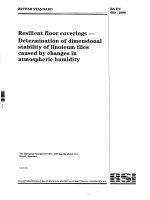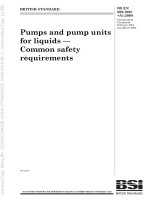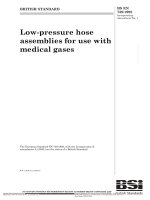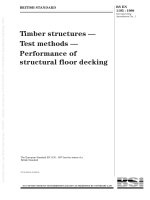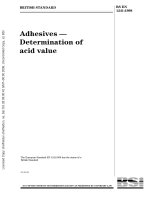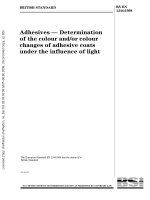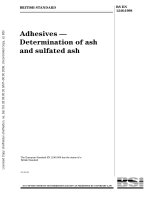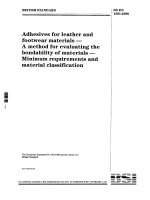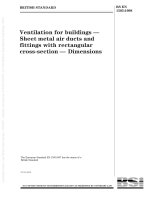Bsi bs en 00793 1998
Bạn đang xem bản rút gọn của tài liệu. Xem và tải ngay bản đầy đủ của tài liệu tại đây (276.59 KB, 26 trang )
BRITISH STANDARD
Particular requirements
for safety of medical
supply units
The European Standard EN 793:1997 has the status of a
British Standard
ICS 11.040.01
NO COPYING WITHOUT BSI PERMISSION EXCEPT AS PERMITTED BY COPYRIGHT LAW
|
|
|
|
|
|
|
|
|
|
|
|
|
|
|
|
|
|
|
|
|
|
|
|
|
|
|
|
|
|
|
|
|
|
|
|
|
|
|
|
|
|
|
|
|
|
|
|
|
|
|
|
|
|
|
|
|
|
|
|
|
|
|
|
|
|
|
|
|
|
|
|
|
|
|
|
|
|
|
|
|
|
|
|
|
|
|
|
|
|
|
|
|
|
|
|
|
|
|
|
|
|
|
|
|
|
|
|
|
|
|
|
|
|
|
|
|
|
|
|
|
|
|
|
|
|
|
|
|
BS EN
793:1998
BS EN 793:1998
National foreword
This British Standard is the English language version of EN 793:1997.
The UK participation in its preparation was entrusted by Technical Committee
CH/44, Anaesthetic machines, breathing attachments, medical gas pipeline systems
and hose assemblies, to Subcommittee CH/44/2, Medical gas supply systems, which
has the responsibility to:
± aid enquirers to understand the text;
± present to the responsible European committee any enquiries on the
interpretation, or proposals for change, and keep the UK interests informed;
± monitor related international and European developments and promulgate
them in the UK.
A list of organizations represented on this committee can be obtained on request to
its secretary.
Cross-references
The British Standards which implement international or European publications
referred to in this document may be found in the BSI Standards Catalogue under the
section entitled ªInternational Standards Correspondence Indexº, or by using the
ªFindº facility of the BSI Standards Electronic Catalogue.
A British Standard does not purport to include all the necessary provisions of a
contract. Users of British Standards are responsible for their correct application.
Compliance with a British Standard does not of itself confer immunity
from legal obligations.
Summary of pages
This document comprises a front cover, an inside front cover, the EN title page,
pages 2 to 22, an inside back cover and a back cover.
This British Standard, having
been prepared under the
direction of the Health and
Environment Sector Board, was
published under the authority of
the Standards Board and comes
into effect on 15 April 1998
BSI 1998
ISBN 0 580 29655 5
Amendments issued since publication
Amd. No.
Date
Text affected
EN 793
EUROPEAN STANDARD
NORME EUROPÊENNE
EUROPẰISCHE NORM
December 1997
ICS 11.040.01
Descriptors: Electromedical equipment, electric power supply, lighting, gas supply, medical gases, gaseous effluent disposal, safety
requirements, accident prevention, protection against electric shocks, protection against mechanical hazards, radiation
protection, fire protection, performance evaluation, equipment specification, marking, colour codes
English version
Particular requirements for safety of medical supply units
Prescriptions particulieÁres relatives aÁ la seÂcurite des
gaines techniques aÁ usage meÂdical
Besondere Anforderungen fuÈr die Sicherheit von
medizinischen Versorgungseinheiten
This European Standard was approved by CEN on 30 October 1997.
CEN members are bound to comply with the CEN/CENELEC Internal Regulations
which stipulate the conditions for giving this European Standard the status of a
national standard without any alteration. Up-to-date lists and bibliographical
references concerning such national standards may be obtained on application to
the Central Secretariat or to any CEN member.
This European Standard exists in three official versions (English, French, German).
A version in any other language made by translation under the responsibility of a
CEN member into its own language and notified to the Central Secretariat has the
same status as the official versions.
CEN members are the national standards bodies of Austria, Belgium, Czech
Republic, Denmark, Finland, France, Germany, Greece, Iceland, Ireland, Italy,
Luxembourg, Netherlands, Norway, Portugal, Spain, Sweden, Switzerland and
United Kingdom.
CEN
European Committee for Standardization
Comite EuropeÂen de Normalisation
EuropaÈisches Komitee fuÈr Normung
Central Secretariat: rue de Stassart 36, B-1050 Brussels
1997 CEN All rights of exploitation in any form and by any means reserved worldwide for CEN national
Members.
Ref. No. EN 793:1997 E
Page 2
EN 793:1997
Foreword
Page
This European Standard has been prepared by
Technical Committee CEN/TC 215, Anaesthetics and
respiratory equipment, the secretariat of which is held
by BSI.
For special national conditions for clauses 6.1bb)
and 6.2aa) see annex AA.
This European Standard has been prepared under a
mandate given to CEN by the European Commission
and the European Free Trade Association and supports
essential requirements of EU Directive(s).
For relationship with EU Directives, see informative
annex ZA which is an integral part of this standard.
Annex AA is a normative part, and annexes BB, CC
and ZA are informative parts, of this standard.
This European Standard shall be given the status of a
national standard, either by publication of an identical
text or by endorsement, at the latest by May 1998, and
conflicting national standards shall be withdrawn at
the latest by May 1998.
According to the CEN/CENELEC Internal Regulations,
the national standards organizations of the following
countries are bound to implement this European
Standard: Austria, Belgium, Czech Republic, Denmark,
Finland, France, Germany, Greece, Iceland, Ireland,
Italy, Luxembourg, Netherlands, Norway, Portugal,
Spain, Sweden, Switzerland and the United Kingdom.
Contents
Foreword
Introduction
Section one Ð General
1
Scope
2
Normative references
3
Terms and definitions
4
General requirements and
requirements for tests
5
Classification
6
Identification, marking and documents
7
Power input
Section two Ð Environmental
conditions
8
Basic safety categories
9
Removable protection means
10 Environmental conditions
11 Not used
12 Not used
Page
2
4
4
4
4
8
8
8
10
10
10
10
10
10
Section three Ð Protection against
electric shock hazards
13 General
14 Requirements related to classification
15 Limitation of voltage and/or energy
16 Enclosures and protective covers
17 Separation
18 Protective earthing, functional earthing
and potential equalization
19 Continuous leakage currents and
patient auxiliary currents
20 Dielectric strength
Section four Ð Protection against
mechanical hazard
21 Mechanical strength
22 Moving parts
23 Surfaces, corners and edges
24 Stability in normal use
25 Expelled parts
26 Vibration and noise
27 Pneumatic and hydraulic power
28 Suspended masses
Section five Ð Protection against
hazards from unwanted or excessive
radiation
29 X-radiation
30 Alpha, beta, gamma, neutron radiation
and other particle radiation
31 Microwave radiation
32 Light radiation (including lasers)
33 Infra-red radiation
34 Ultraviolet radiation
35 Acoustical energy (including
ultrasonics)
36 Electromagnetic compatibility
Section six Ð Protection against
hazards of ignition of flammable
anaesthetic mixtures
37 Locations and basic requirements
38 Marking, accompanying documents
39 Common requirements for category
AP and category APG equipment
40 Requirements and tests for category
AP equipment, parts and components
thereof
41 Requirements and tests for category
APG equipment, parts and
components thereof
10
10
10
10
10
10
10
10
10
12
12
12
12
12
12
12
12
12
12
12
12
12
12
12
12
12
12
12
13
BSI 1998
Page 3
EN 793:1997
Page
Section seven Ð Protection against
excessive temperatures and other
safety hazards
42 Excessive temperatures
43 Fire prevention
44 Overflow, spillage, leakage, humidity,
ingress of liquids, cleaning,
sterilization and disinfection
45 Pressure vessels and parts subject to
pressure
46 Human errors
47 Electrostatic charges
48 Material in applied parts in contact
with the body of the patient
49 Interruption of the power supply
Section eight Ð Accuracy of
operating data and protection against
hazardous output
50 Accuracy of operating data
51 Protection against hazardous output
Section nine Ð Abnormal operation
and fault conditions: environmental
tests
52 Abnormal operation and fault
conditions
53 Environmental tests
Section ten Ð Constructional
requirements
54 General
55 Enclosures and covers
56 Components and general assembly
57 Mains parts, components and layout
58 Protective earthing - terminals and
connections
59 Construction and layout
Annex AA (normative) Special national
conditions
Annex BB (informative) Bibliography
Annex CC (informative) Rationale
Annex ZA (informative) Clauses of this
European Standard addressing essential
requirements or other provisions of
EU Directives
BSI 1998
13
13
13
13
13
13
13
13
13
13
www.bzfxw.com
13
13
13
13
14
14
14
14
19
19
19
21
Page 4
EN 793:1997
Section one ± General
EN 739:1998, Low-pressure hose assemblies for use
with medical gases
EN 1441, Medical devices Ð Risk analysis
EN ISO 3744, Acoustics Ð Determination of sound
power levels of noise sources using sound pressure Ð
Engineering method in an essentially freefield
condition over a reflecting plane
(ISO 3744:1994)
EN 60598-1, Luminaires Ð Part 1: General
requirements and tests
(IEC 598-1:1992, modified)
EN 60601-1:1990, Medical electrical equipment Ð
Part 1: General requirements for safety
EN 60601-1-2, Medical electrical equipment Ð Part 1:
General requirements for safety Ð Electromagnetic
compatibility Ð Requirements and tests
EN 60669-1, Switches for household and similar fixed
electrical installations Ð Part 1: General requirements
(IEC 669-1:1993, modified)
IEC 79-4, Electrical apparatus for explosive gas
atmospheres Ð Part 4: Method of test for ignition
temperature
IEC 884-1, Plugs and socket-outlets for household and
similar purposes Ð General requirements
1 Scope
3 Terms and definitions
Clause 1 of EN 60601-1:1990 applies with the following
addition:
This standard applies to medical supply units as
defined in 3.4.
1.3 Particular Standards
This Particular Standard amends EN 60601-1:1990.
The requirements of this Particular Standard take
priority over those of EN 60601-1:1990.
Clause 2 of EN 60601-1:1990 applies with the following
additions:
3.1
equipment
single self-contained unit or combination of units
provided with one or more permanently fixed
connections to the building services, e.g. electricity,
medical gas(es), liquid(s) or anaesthetic gas scavenging
systems
3.2
junction point
connection point between the medical supply unit and
the fixed building services
3.3
medical gas
any gas or mixture of gases intended to be
administered to patients for therapeutic, diagnostic or
prophylactic purposes, or for surgical tool applications
3.4
medical supply unit
prefabricated permanently installed equipment of
Class I, Type B for application in medical areas such as
general wards and special purpose areas, e.g. operating
theatres, induction rooms, recovery wards, intensive
care of therapy units and other intermediate care
areas. It is intended to supply electric power and/or
medical gases and/or liquids
Introduction
This Particular Standard amends EN 60601-1:1990
Medical electrical equipment, Part 1: General
requirements for safety.
As stated in EN 60601-1:1990 the requirements of this
Particular Standard take priority over those of
EN 60601-1:1990.
As in EN 60601-1:1990 the requirements are followed
by the relevant tests. The structure of this Particular
Standard corresponds to that of EN 60601-1:1990 and
the sections, clauses and subclauses refer to those
of EN 60601-1:1990.
Clauses, subclauses, tables and figures additional to
those in EN 60601-1:1990 are numbered beginning
at ª101º. Additional annexes are lettered beginning
at ªAAº except for annex ªZAº.
Additional items in lettered lists are lettered
beginning ªaa)º.
Rationales for some of the requirements of this
standard are given in annex CC. Such requirements are
indicated by the letter ªRº after the clause number.
2 Normative references
This European Standard incorporates by dated or
undated reference, provisions from other publications.
These normative references are cited at the
appropriate places in the text and the publications are
listed hereafter. For dated references subsequent
amendment to or revisions of any of these apply to
this European Standard only when incorporated in it
by amendment or revision. For undated references the
latest edition of the publication referred to applies.
Appendix L of EN 60601-1:1990 applies with the
following additions:
EN 737-1, Medical gas pipeline systems Ð Part 1:
Terminal units for compressed medical gases and
vacuum
prEN 737-2, Medical gas pipeline systems Ð Part 2:
Anaesthetic gas scavenging disposal systems Ð Basic
requirements
prEN 737-3, Medical gas pipeline systems Ð
Part 3: Pipelines for compressed medical gases and
vacuum Ð Basic requirements
EN 737-4, Medical gas pipeline systems Ð Part 4:
Terminal units for anaesthetic gas scavenging
systems
www.bzfxw.com
NOTE Medical supply units can include medical electrical
equipment or systems or parts of such equipment or systems
which might be applied to diagnosis, therapeutics and
communications. Medical supply units can consist of modular
sections for electrical supply, lighting for therapy or illumination,
communication, supply of medical gases and liquids, anaesthetic
gas scavenging systems. Typical examples of medical supply units
are given in Figures 101, 102 and 103.
BSI 1998
Page 5
EN 793:1997
www.bzfxw.com
1
2
3
4
5
Ambient lighting fitting
Electrical socket
Mains supply
Intercommunication, safety extra-low voltage
Recessed equipment
6
7
8
9
10
Barrier
Terminal unit
Pipeline installation
Reading light
Safety distance as distance from centre to centre
Figure 101 Ð Sectional drawing of typical medical supply unit for patient care rooms
BSI 1998
Page 6
EN 793:1997
www.bzfxw.com
1
2
3
4
Electrical socket
Mains supply
Intercommunication, safety extra-low voltage
Recessed equipment
5
6
7
8
Barrier
Terminal unit
Pipeline installation
Safety distance as distance from centre to centre
Figure 102 Ð Sectional drawing of typical medical supply unit for
intensive care rooms and operating theatres
BSI 1998
Page 7
EN 793:1997
www.bzfxw.com
1 Barrier
2 Terminal units
3 Recessed equipment, low current electro installation,
intercommunication safety extra-low voltage
4 Electrical socket
5 Safety distance measured on the surface as
distance from centre to centre
6 Flexible hoses
7 Mains installation
8 Low current installation
Figure 103 Ð Sectional drawing of typical non-rigid medical supply unit
BSI 1998
Page 8
EN 793:1997
4 General requirements and requirements
for test
4.1 Modifications to clause 3 of EN 60601-1:1990
Clause 3 of EN 60601-1:1990 applies with the following
additions:
3.6 Add the following items
3.6aa) R An oxidant leak which is not detected by
e.g. an alarm or periodic inspection shall be
considered a normal condition and not a single fault
condition.
3.6bb) Medical supply units shall, when transported,
stored, installed, operated in normal use and
maintained according to the instructions of the
manufacturer, cause no safety hazard which could
be foreseen using risk analysis procedures in
accordance with EN 1441 and which is connected
with their intended application in normal condition
and in single fault condition.
3.101 Equipment and components incorporated into
the medical supply unit shall comply with the
Particular Standard(s) for such equipment or
components.
4.2 Clause 4 of EN 60601-1:1990
Clause 4 of EN 60601-1:1990 applies.
5 Classification
Clause 5 of EN 60601-1:1990 applies.
6 Identification, marking and documents
Clause 6 of EN 60601-1:1990 applies with the following
amendments:
6.1 Marking on the outside of equipment or
equipment parts
a) Mains operated equipment
Replace with the following:
Mains operated equipment, including separable
components thereof which have a mains part,
shall be provided at least with permanently affixed
and clearly legible marking on the outside of the
major part of the equipment with an indication of
origin and model or type reference.
g) Connection to the supply
Replace with the following:
Due to the possible complexity of external
marking, diagrams indicating all electrical and
electronic connections to the medical supply unit
shall be located at the junction point inside the
equipment. For electrical connections the diagram
shall indicate voltages, number of phases and
number of circuits. For electronic connections, the
diagram shall indicate connector numbers and
wire identification.
k) Mains power output
Replace with the following:
Mains socket outlets for special purpose areas
(e.g. x-ray equipment) shall be marked with type
of mains, rated voltage, rated current and the label
ªx-rayº.
NOTE Mains socket outlets for special purpose areas which
are fused in a single circuit can be marked with identical
numbers.
l) Classification
Replace dash three with the following:
± Medical supply units shall be designed and
constructed as Class I, Type B equipment
according to the degree of protection against
electric shock. Built-in units of Type BF or CF and
outlets forming part of them, contained in medical
supply units, shall be clearly marked with the
relevant symbols according to annex D, Table D II
of EN 60601-1:1990.
y) Earth terminals
Add the following:
± Facilities for the connection of a potential
equalization conductor (if provided) shall be
marked with symbol 9 of annex D, Table DI of
EN 60601-1:1990.
Add the following:
aa) Particular applications
If the medical supply unit is intended to be used in
conjunction with patient monitors, for
electromyogram and/or electroencephalogram and/or
electrocardiogram, the medical supply unit shall be
marked with the particular application as follows:
www.bzfxw.com
± for electromyogram
± for electroencephalogram
± for electrocardiogram
EMG
EEG
ECG or EKG
bb) Terminal units
± Terminal units for medical gases shall be marked
in accordance with EN 737-1. Colour coding, if
used, shall be in accordance with EN 737-1.
See annex AA for special national conditions.
± Terminal units for anaesthetic gas scavenging
systems shall be marked in accordance with
EN 737-4. Colour coding, if used, shall be in
accordance with EN 737-4.
± Terminal units for liquids shall be marked with
the name of the liquid in accordance with
Table 101 or the equivalent in the national
language.
NOTE Colour coding, if used, should be in accordance with
national standards if available.
Table 101 Ð Marking for liquids
Name of liquid
Potable water, cold
Potable water, warm
Cooling water
Cooling water, feed-back
De-mineralized water
Distilled water
Dialysing concentrate
Dialysing permeate
BSI 1998
Page 9
EN 793:1997
6.2 Marking on the inside of equipment and
equipment parts
Add the following:
aa) Junction points and pipelines for medical gases
shall be marked in accordance with prEN 737-3.
Colour coding, if used, shall be in accordance
with prEN 737-3.
See annex AA for special national conditions.
bb) Junction points and pipelines for anaesthetic gas
scavenging systems shall be marked in accordance
with prEN 737-2. Colour coding, if used, shall be in
accordance with prEN 737-2.
cc) Junction points and pipelines for liquids shall be
marked with the name of the liquid in accordance
with Table 101 or the equivalent in the national
language.
NOTE Colour coding, if used, should be in accordance with
national standards if available.
6.8 Accompanying documents
Clause 6.8 of EN 60601-1:1990 applies with the
following amendments:
6.8.2 Instruction for use
a) General information
Add the following:
± Instructions for use shall state which parts of
the equipment are capable of bearing additional
loads. The safe working load shall be stated.
± Instructions for use shall state that in any health
care facility, terminal units of only one type
(i.e. with the same set of dimensions for probe
and socket) should be used for the same liquid.
± If flexible hoses and hose assemblies are used
for medical gas supply, anaesthetic gas scavenging
and liquid supply for operator adjustable systems,
e.g. ceiling pendants, the instructions for use shall
include a procedure for and the frequency of
inspection and replacement.
± If flexible hoses are used for medical gas supply
for operator adjustable systems, e.g. ceiling
pendants, the instructions for use shall state that
the following tests given in prEN 737-3 shall be
carried out following modification or replacement
of the flexible hose:
± test for leakage
± test for obstruction
± test for particulate contamination
± test of gas identity
± If flexible hoses are used for anaesthetic gas
scavenging for operator adjustable systems,
e.g. ceiling pendants, the instructions for use shall
state that the following tests given in prEN 737-2
shall be carried out following modification or
replacement of the flexible hose:
± test for leakage
± test of flow and pressure drop
BSI 1998
± If flexible hoses are used for liquid supply for
operator adjustable systems, e.g. ceiling pendants,
the instructions for use shall state that the
following test, given in 59.103.2b), shall be carried
out following modification or replacement of the
flexible hose:
± test for leakage
± If live parts of the electrical system can be
touched during maintenance of the piping systems,
the manufacturer shall state the precautions
required for safe maintenance when safety covers
have been removed.
b) Responsibility of the manufacturer
Replace with the following:
The manufacturer/supplier shall provide evidence
that the following production tests have been
performed for each unit and that the specified
requirements are met:
i) Impedance of protective earthing in accordance
with 18f) of EN 60601-1:1990;
ii) Earth leakage current in accordance with 19.3
and 19.4 of EN 60601-1:1990;
iii) The following requirements and tests:
± requirements as in 59.101.1, 59.102.1
and 59.103.1;
± flow and pressure drop in accordance with
59.101.2a) and 59.102.2a);
± no cross-connections in accordance with
59.101.2b), 59.102.2b) and 59.103.2a);
± leakage in accordance with 59.101.2c),
59.102.2c) and 59.103.2b);
± pressure tests in accordance with 59.101.2d)
and 59.102.2d).
Add the following:
aa) Specifications for installations and use
Medical supply units shall be installed, tested and
used in compliance with prEN 737-2, prEN 737-3 and
the manufacturer's instructions.
NOTE An IEC document is in preparation on this subject.
(See IEC 64/747/FDIS:1995 in annex BB)
6.8.3 Technical descriptions
Add the following:
aa) Disclosure by the manufacturer
± The manufacturer shall provide evidence that
the noise levels of clause 26 are not exceeded.
± The manufacturer shall specify the flow and
pressure drop characteristics of the medical
supply unit both for medical gases and anaesthetic
gas scavenging, if fitted.
± The manufacturer shall submit upon request
evidence of the residual hydrocarbon content on
the inner surface of the medical gas pipes.
NOTE The maximum permissible level of residual
hydrocarbon content on the inner surface of medical gas
pipes is under consideration by CEN/TC 133.
Page 10
EN 793:1997
7 Power input
Clause 7 of EN 60601-1:1990 applies.
19 Continuous leakage currents and
patient auxiliary currents
Clause 19 of EN 60601-1:1990 applies with the
following amendments:
Section two Ð Environmental conditions
Clause 8 of EN 60601-1:1990 applies.
19.3 Allowable values
Add to examples of such equipment in Note 3 of
table IV of EN 60601-1:1990:
± ªMedical supply unitsº
9 Removable protection means
20 Dielectric strength
Not used. Replaced by subclause 6.1z).
Clause 20 of EN 60601-1:1990 applies.
8 Basic safety categories
10 Environmental conditions
Clause 10 of EN 60601-1:1990 applies.
11 Not used
12 Not used
Section three Ð Protection against
electrical shock hazards
13 General
Clause 13 of EN 60601-1:1990 applies with the
following addition:
Lighting fixtures, built in or mounted on medical
supply units shall comply with EN 60598-1.
14 Requirements related to classification
Clause 14 of EN 60601-1:1990 applies.
15 Limitation of voltage and/or energy
Clause 15 of EN 60601-1:1990 applies.
16 Enclosures and protective covers
Clause 16 of EN 60601-1:1990 applies.
17 Separation
Clause 17 of EN 60601-1:1990 applies.
18 Protective earthing, functional
earthing and potential equalization
Clause 18 of EN 60601-1:1990 applies with the
following additions:
aa) Terminal units for compressed medical gases and
vacuum and for anaesthetic gas scavenging systems
do not require to be connected to the earth terminal.
bb) All earth conductors of circuits from the existing
mains supply shall be connected in the medical
supply unit with a bus-bar.
Section four Ð Protection against
mechanical hazard
21 Mechanical strength
Clause 21 of EN 60601-1:1990 applies with the
following addition:
21.101
21.101.1 Dynamic forces
Medical supply units shall be subjected to an impact as
described in 21.101.2. After the impact, the live parts
shall not become accessible, terminal units shall
neither mechanically malfunction nor leak and existing
protective devices shall remain intact.
21.101.2 Impact resistance test
A bag of 0,5 m width approximately half-filled with
sand to give a total weight of 200 N suspended so as to
give a pendulum length of 1 m, shall be released from a
horizontal deflection of 0,5 m so as to hit the medical
supply unit, mounted according to the manufacturer's
instructions. The test configuration is shown in
Figure 104. The test shall be repeated at at least one
more position.
NOTE The occurrence of cracks in mouldings does not constitute
failure of the test.
21.101.3 Static forces
Parts of medical supply units designed for additional
loads shall be subjected to a test load of twice the safe
working load specified by the manufacturer as
described in 21.101.4.
The medical supply units and their supports designed
for additional loads shall not be permanently deformed
nor deflect by more than 108 with reference to the
non-load bearing surfaces.
21.101.4 Static load test
The test load shall be uniformly distributed over the
medical supply unit according to the manufacturer's
specification.
BSI 1998
Page 11
EN 793:1997
1
2
3
4
5
Length of pendulum
Deflection
Mounted medical supply unit
Most vulnerable point (example)
Bag of weight 200 N
Figure 104 Ð Impact resistance test
BSI 1998
Page 12
EN 793:1997
22 Moving parts
33 Infra-red radiation
Clause 22 of EN 60601-1:1990 applies.
Clause 33 of EN 60601-1:1990 applies.
23 Surfaces, corners and edges
34 Ultraviolet radiation
Clause 23 of EN 60601-1:1990 applies.
Clause 34 of EN 60601-1:1990 applies.
24 Stability in normal use
35 Acoustical energy (including
ultrasonics)
Clause 24 of EN 60601-1:1990 applies.
25 Expelled parts
Clause 25 of EN 60601-1:1990 applies.
26 Vibration and noise
Add the following:
26.101 Within the frequency spectrum, individual peak
noise levels shall not be in excess of 35 dB(A).
Except for noise caused by therapeutic or diagnostic
measures or by adjustment of the medical supply unit
(e.g. by lifting or lowering), during operation at
1,1 times the rated voltage at nominal frequency, the
medical supply unit shall not produce acoustic energies
in excess of 30 dB(A).
The manufacturer shall provide evidence that specified
sound levels are not exceeded when measured
according to EN ISO 3744.
27 Pneumatic and hydraulic power
Clause 27 of EN 60601-1:1990 applies.
28 Suspended masses
Clause 28 of EN 60601-1:1990 applies.
Clause 35 of EN 60601-1:1990 applies.
36 Electromagnetic compatibility
Replace clause 36 with the following.
EN 60601-1-2 shall apply with the following
amendments to all components incorporated into the
medical supply unit which can generate magnetic
(inductive) interferences.
36.101 Magnetic (inductive) interferences
Medical supply units shall be designed to minimize the
emission of magnetic flux. The peak-to-peak values of
the magnetic flux generated by the medical supply unit
at a distance of 0,75 m shall not exceed the values for
specific applications as follows:
± electromyogram application:
0,1 3 1026 Tesla
± electroencephalogram application: 0,2 3 1026 Tesla
± electrocardiogram application:
0,4 3 1026 Tesla
These applications shall be labelled in accordance with
clause 6.1aa).
NOTE 1 In addition to the components determined by systems or
appliance, various other electrical components are installed by
users in medical supply units, such as components in peripheral
systems or appliances e.g. peripheral nurse call systems,
computers, etc.
NOTE 2 An example of a test method is described in
DIN VDE 0107/11.89.
Section five Ð Protection against hazards Section six Ð Protection against hazards
of ignition of flammable anaesthetic
from unwanted or excessive radiation
mixtures
29 X-radiation
37 Locations and basic requirements
Clause 29 of EN 60601-1:1990 applies.
Clause 37 of EN 60601-1:1990 applies.
30 Alpha, beta, gamma, neutron radiation
and other particle radiation
Clause 30 of EN 60601-1:1990 applies.
31 Microwave radiation
Clause 31 of EN 60601-1:1990 applies.
32 Light radiation (including lasers)
Clause 32 of EN 60601-1:1990 applies.
38 Marking, accompanying documents
Clause 38 of EN 60601-1:1990 applies.
39 Common requirements for category AP
and category APG equipment
Clause 39 of EN 60601-1:1990 applies.
40 Requirements and tests for
category AP equipment, parts and
components thereof
Clause 40 of EN 60601-1:1990 applies.
BSI 1998
Page 13
EN 793:1997
41 Requirements and tests for
category APG equipment, parts and
components thereof
45 Pressure vessels and parts subject to
pressure
Clause 45 of EN 60601-1:1990 does not apply.
Clause 41 of EN 60601-1:1990 applies.
46 Human errors
Not used.
Section seven Ð Protection against
excessive temperatures and other safety
hazards
42 Excessive temperatures
Clause 42 of EN 60601-1:1990 applies with the
following amendments:
Add the following:
42.101 The maximum temperatures of lighting fixtures
and their exposed components shall not exceed the
maximum temperature stated in EN 60598-1.
43 R Fire prevention
Clause 43 of EN 60601-1:1990 applies with the
following amendment:
43.2 Replace with the following.
In order to reduce the risk to patients, other persons
or the surroundings due to fire, ignitable material,
under normal and single fault condition, shall not, at
the same time, be subjected to conditions in which:
± the temperature of the material is raised to its
minimum ignition temperature and
± an oxidant is present.
Determine the minimum ignition temperature in
accordance with IEC 79-4 using the oxidizing
conditions present under the normal and single fault
condition.
Compliance is checked by determining the temperature
the material is raised to under the normal and single
fault condition.
If sparking can occur under normal or single fault
conditions, the material subjected to the energy
dissipation of the spark shall not ignite under the
oxidizing conditions present.
Compliance is checked by observing if ignition occurs
under the most unfavourable combination of normal
conditions with a single fault.
44 Overflow, spillage, leakage, humidity,
ingress of liquids, cleaning, sterilization
and disinfection
Clause 44 of EN 60601-1:1990 applies.
47 Electrostatic charges
Not used.
48 Material in applied parts in contact
with the body of the patient
Clause 48 of EN 60601-1:1990 does not apply.
49 Interruption of the power supply
Clause 49 of EN 60601-1:1990 applies.
Section eight Ð Accuracy of operating
data and protection against hazardous
output
50 Accuracy of operating data
Not used.
51 Protection against hazardous output
Clause 51 of EN 60601-1:1990 applies.
Section nine Ð Abnormal operation and
fault conditions, environmental tests
52 Abnormal operation and fault
conditions
Clause 52 of EN 60601-1:1990 applies.
53 Environmental tests
Clause 53 of EN 60601-1:1990 applies.
Section ten Ð Constructional
requirements
54 General
Clause 54 of EN 60601-1:1990 applies.
55 Enclosures and covers
Clause 55 of EN 60601-1:1990 applies.
BSI 1998
Page 14
EN 793:1997
56 Components and general assembly
Add the following:
Clause 56 of EN 60601-1:1990 applies with the
following amendments:
58.102 Bus bar
All protective earth conductors, of circuits from the
existing mains supply shall be connected in the
medical supply unit to a bus bar with a conductance
equivalent to at least that of 16 mm2 copper.
The bus bar for protective earth conductors shall also
be equipped with a terminal for connection to a
protective earth conductor of at least 16 mm2
cross-section. Facilities for potential equalization
conductors shall be connected to the bus bar of
protective earth conductors if there is no bus bar for
potential equalization. see Figure 106 for an example.
All terminals shall be secured against unintentional
loosening.
The medical gas pipeline shall not be used as a bus
bar.
56.1 General
Add the following:
aa) Sockets for potential equalization conductors, if
provided, shall be recessed.
Compliance shall be tested by inspection.
57 Main parts, components and layout
Clauses 57.1a) to m) of EN 60601-1:1990 are replaced
by the following:
57.1 Isolation from the supply mains
Medical supply units shall not include externally
accessible master switches or fuses capable of isolating
a complete electrical circuit.
Mains socket outlets shall not be provided with mains
switches.
NOTE Unintentional operation of mains switches or mains fuses
if integrated in the medical supply unit could endanger the patient.
57.2 Mains connectors, appliance inlets and the
like
Clause 57.2 of EN 60601-1:1990 applies with the
following amendments:
Add the following:
aa) Sockets for x-ray equipment shall be in
accordance with IEC 884-1.
57.6 Mains fuses and over-current releases
Clause 57.6 of EN 60601-1:1990 does not apply. see
clause 57.1 in this standard.
58 Protective earthing ± terminals and
connections
Clause 58 of EN 60601-1:1990 applies with the
following amendments:
58.2 Add the following:
Two examples are given in Figure 105.
Add the following:
58.101 Conductors
Protective earth conductors shall each have a
cross-section of at least 2,5 mm2 of copper and shall be
individually fixed to the protective earth terminal.
Potential equalization conductors, if provided, shall
each have a cross-section of at least 4 mm2 of copper
and shall be individually detachable from the potential
equalization sockets.
NOTE A metal section of the medical supply unit of equivalent
conductance can be used as a bus bar.
59 Construction and layout
Clause 59 of EN 60601-1:1990 applies with the
following amendments:
59.1 Internal wiring
e) Separation of circuits
Replace with the following:
NOTE Conductors of different mains circuits of the same
voltage do not require mechanical separation. In diagnostic and
medical care facilities at least one separate circuit which can
have more than one mains socket outlet should be provided for
each bed. A separate circuit should be provided for each
haemodialysis machine and x-ray equipment. In general wards
one mains circuit can serve more than one bed.
Add the following:
aa) Intercommunication circuits
If wiring for intercommunication, such as nurse call
systems, wiring for radio transmission, telephone
wiring, signal wiring for biophysical parameters,
other data transmission conductors etc. are ducted
together with mains cables or gas pipes in medical
supply units, electrically safe operation under single
fault condition shall be ensured.
NOTE This can be achieved, for example, by double insulation
of wiring for intercommunication facilities or separation by
metallic partitions or a distance of at least 50 mm. For an
example see Figure 101.
bb) Double insulation
If mains conductors are installed together with
medical gas pipelines, these conductors shall be
double-insulated.
cc) Maintenance
The design features shall either ensure that in case
of maintenance on the piping system no live parts of
the electrical system can be touched, or the
manufacturer shall indicate on the removable safety
covers and in accompanying documents how by
other precautions safe maintenance can be assured.
See clause 16d) of EN 60601-1:1990.
BSI 1998
Page 15
EN 793:1997
1
2
3
4
5
6
Cupal washer Cu/Al (Copper surface uppermost)
Spring washer
Cable bracket
Lock washer
Supply unit section (e.g. aluminium)
Supply unit section (e.g. ferrous)
Figure 105 Ð Typical examples for protection measures
against loosening and corrosion of potential equalization
and earth-conductor facilities
BSI 1998
Page 16
EN 793:1997
1 Medical supply unit
PE connection of main plug sockets
PA potential equalization sockets
NOTE There should be no additional potential equalization detachable bridge.
Figure 106 Ð Example of the terminal device for
medical supply units in accordance with IEC 364-5-54
59.3 Add the following;
If pulse relays are fitted, they shall comply with
EN 60669-1 and EN 60601-1:1990 clause 57.10.
Add the following new subclauses
59.101 Medical gas supply construction
59.101.1 Requirements
a) Medical gas pipelines shall be made of materials
according to prEN 737-3.
NOTE 1 Pure copper is recommended for compressed medical
gases and vacuum.
NOTE 2 The dimensions of pipes which supply terminal units
for compressed medical gases and vacuum should permit the
system to function in accordance with prEN 737-3.
NOTE 3 Pipes to pressure gauges and other measuring and
control equipment can have small cross-sections.
Interconnections of pipes shall be in accordance
with prEN 737-3. Cutting ring connections and
compression joints shall not be used.
b) R Flexible hoses and hose assemblies shall not be
used within medical supply units except for the
operator adjustable portions (e.g. on ceiling
pendants).
If flexible hoses and hose assemblies are used,
means shall be provided to allow periodic inspection
and replacement.
If flexible hoses are used, they shall comply with
EN 739:1998 except for clauses 5.4.2.1, 5.4.7, 5.4.8
and 5.4.9. The minimum bursting pressure of hoses
used for all services except vacuum shall be not less
than 8000 kPa at 23 8C and not less than 6400 kPa
at 40 8C. Evidence shall be provided by the
manufacturer.
If flexible hoses are accessible to the operator for
removal, they shall be incorporated in hose
assemblies which comply with EN 739:1998 except
for clauses 5.4.2.1, 5.4.7, 5.4.8 and 5.4.9. The
minimum bursting pressure of hoses used for all
services except vacuum shall be not less
than 8000 kPa at 23 8C and not less than 6400 kPa
at 40 8C. Evidence shall be provided by the
manufacturer.
If flexible hoses are used, the accompanying
documents for the medical supply unit shall include
a procedure for, and the frequency of, inspection and
replacement of the flexible hoses and shall specify
the tests to be carried out following such
replacement [see clause 6.8.2a)].
If hose assemblies are used, they shall comply with
EN 739:1998 except for clause 5.4.2.1, and the
accompanying documents for the medical supply
units shall include a procedure for, and the
frequency of, inspection and replacement of the hose
assemblies [see clause 6.8.2a)].
BSI 1998
Page 17
EN 793:1997
c) During the design phase, constructional provisions
shall be made so that piping is not exposed to
temperatures above 50 8C and flexible hoses, if used,
are not exposed to temperatures above 40 8C caused
e.g. by lighting facilities, transformers, etc.
d) Control knobs and spindles of flow control
valves, if fitted, shall be captive, such that they
cannot be disengaged without the use of a tool.
e) The electrical compartment within a medical
supply unit shall be separated from the liquid and
gas compartment by a partition wall. Liquid
compartments in horizontal mountings shall be
located below electrical compartments.
f) Terminal units for oxidizing medical gases, for
anaesthetic gas scavenging systems and for liquids
shall be located at least 0,2 m from any mains socket
outlet.
NOTE The effect of thermal expansion should be taken into
account.
59.101.2 Production tests
The compressed medical gases and vacuum systems
shall be tested at ambient temperature to ensure the
following:
a) That the medical gas supply system meets the
manufacturer's specified flow and pressure drop
performance [see clause 6.8.3aa)].
b) That there are no cross-connections between
pipelines for different gases.
NOTE Test procedures for cross-connections are given
in prEN 737-3.
c) That when pressurized with clean, oil free, dry air
or nitrogen at the nominal distribution pressure
specified in prEN 737-3, the leakage from the portion
of the pipeline for each compressed medical gas and
vacuum included in the medical supply unit shall not
exceed the value of 0,296 ml/min (0,03 kPa l/min)
times the number of terminal units connected to that
portion of pipeline.
NOTE For the vacuum supply, the test can be carried out
at 400 kPa positive pressure.
d) That each portion of pipeline can withstand a
pressure of two times the nominal distribution
pressure specified in prEN 737-3.
e) That pipelines are made of copper and
interconnections are in accordance with prEN 737-3.
59.102 Anaesthetic gas scavenging system
construction
59.102.1 Requirements
a) The construction of the anaesthetic gas
scavenging system shall comply with prEN 737-2.
b) Flexible hoses shall not be used within medical
supply units except for the operator adjustable
portions (e.g. on ceiling pendants).
If flexible hoses are used, means shall be provided
to allow periodic inspection and replacement.
BSI 1998
If flexible hoses are used, the accompanying
documents for the medical supply unit shall include
a procedure for, and the frequency of, inspection and
replacement of the flexible hoses and shall specify
the tests to be carried out following such
replacement [see clause 6.8.2a)].
c) each portion of the pipeline for gases under
pressure shall withstand a pressure of two times the
nominal operating pressure.
59.102.2 Production tests
The anaesthetic gas scavenging system installed on
each medical supply unit shall be tested to ensure the
following:
a) That the anaesthetic gas scavenging system meets
the manufacturer's specified flow and pressure drop
performance [see clause 6.8.3aa)].
b) That there are no cross-connections, between
pipelines for different gases.
c) That when pressurized with clean, oil free, dry air
or nitrogen at the nominal operating pressure
specified in prEN 737-2, the leakage of the portion of
the pipeline for the anaesthetic gas scavenging
system included in the medical supply unit does not
exceed the value of 2,96 ml/min (0,3 kPa l/min) times
the number of terminal units connected to that
portion of pipeline.
59.103 Liquid supply construction
59.103.1 R Requirements
a) Pipelines for potable water (warm or cold) and
cooling water (warm or cold) shall be made of
copper or stainless steel.
b) Pipelines for de-mineralized water (cold), distilled
water, dialysing concentrate and dialysing permeate
shall be made of corrosion resistant material.
NOTE Stainless steel with a corrosion resistance at least
equivalent to CrNiMoTi 18 10 ± ISO 683-13, Type 15 or
appropriate PVC or appropriate polypropylene should be used
for dialysing concentrate and dialysing permeate pipelines.
c) Flexible hoses shall not be used within medical
supply units except for the operator adjustable
portions (e.g. on ceiling pendants).
If flexible hoses are used, means shall be provided
to allow periodic inspection and replacement.
If flexible hoses are used, the accompanying
documents for the medical supply unit shall include
a procedure for, and the frequency of, inspection and
replacement of the flexible hoses and shall specify
the tests to be carried out following such
replacement [see clause 6.8.2a)].
The material of the flexible hoses selected for any
liquid supply shall be compatible with the liquid
contained in those hoses with regard to strength,
long term stability and corrosion resistance under
the operating conditions specified by the
manufacturer.
Page 18
EN 793:1997
Evidence shall be provided by the manufacturer.
d) Pipes and hoses for medical gases may be
installed together with piping for liquids. If fitted
together in horizontal mountings, gas pipes shall be
located above liquid pipes.
NOTE 1 Pipelines for dialysing solutions should be installed in
a single recirculating loop.
NOTE 2 Hot water or wet steam may be used for
pasteurisation of pipelines for dialysing solutions. Means should
be provided to protect other components from excessive
temperature.
NOTE 3 Turbulence and dead spaces should be avoided by
design.
e) Metallic pipe connections and branches to the
terminal units shall be welded or brazed. Flaring and
similar methods shall not be used. Cutting ring
connections and compression joints for copper pipes
shall not be used. To prevent oxide formation inside
the pipes they shall be filled and rinsed with a
suitable inert gas during welding or brazing. Pipe
connections in pipelines for liquids shall be bonded
by means of sleeves without changes in diameter.
f) The liquid supply system shall be designed and
manufactured to minimize health risks due to
substances leached from the system.
Evidence shall be provided by the manufacturer.
59.103.2 Production tests
Each liquid supply unit shall be tested to ensure the
following:
a) That there are no cross-connections between
pipelines for different liquids.
b) That when pressurized with clean, oil free, dry air
or nitrogen at 1,5 times the operating pressure
specified by the manufacturer, the leakage from the
portion of the pipeline for each liquid included in
the medical supply unit shall not exceed the value
of 0,296 ml/min (0,03 kPa l/min) times the number of
terminal units connected to that portion of pipeline.
c) That the requirements of 59.103.1 are met.
59.104 Terminal unit construction
59.104.1 Terminal units for medical gases shall comply
with EN 737-1.
59.104.2 Terminal units for anaesthetic gas scavenging
systems shall comply with EN 737-4.
59.104.3 Terminal units for liquids
a) Terminal units for liquids shall comprise either:
± a flow control valve fitted with a check valve
and at the outlet a hose insert for the following:
potable water, cold
potable water, warm
cooling water
cooling water, feed-back
de-mineralized water
distilled water
or
± a quick-connect socket and probe for the
following:
dialysing concentrate
dialysing permeate
b) Control knobs and spindles of flow control
valves, if fitted, shall be captive such that they
cannot be disengaged without the use of a tool.
c) Quick-connect sockets and probes, if fitted, shall
both be equipped with a check valve to ensure
automatic closure during release.
d) If probes and sockets are used for dialysing
concentrate and dialysing permeate, the probe shall
be fitted on the medical supply unit.
e) R The materials shall be compatible with the
liquids under the operating conditions specified by
the manufacturer.
NOTE Stainless steel with a corrosion resistance at least
equivalent to CrNiMoTi, 18 10 ± ISO 683/13 type 15 should be
used for terminal units for dialysing solutions.
Evidence shall be provided by the manufacturer.
f) The nominal internal diameters for quick-connect
sockets and probes, if fitted, shall be as follows:
Dialysing concentrate:
Dialysing permeate:
4 mm
6 mm
g) If quick-connect sockets and probes are used for
the discharge of dialysis solutions, they shall have
different dimensions from all the others used.
h) Compliance with clauses 59.104.3a) to d) and f)
and g) shall be checked by visual inspection.
BSI 1998
